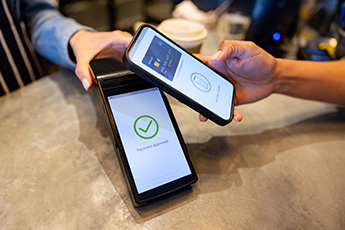Items include
- 159 BID Newsletters
digital banking

By 2027, 51% of e-commerce purchases will be via digital wallet. We discuss why digital wallet share is important for CFIs, along with strategies to get the top spot.

Comprehensive “super apps” that manage messaging, financial services, payments, and other tools are targeting small businesses. We detail what these apps can do and how you can compete.

Give commercial customers a central place to connect with all their financial matters and you may improve the odds of becoming their primary bank.

We talk about the need for CFIs to have a quality digital onboarding process. But what exactly makes an onboarding process convenient, and how does it impact the overall customer experience? We explain the qualities a CFI needs in its onboarding process to compete successfully for new customers and keep existing ones.

For small businesses that don’t need a loan, mobile banking is one of the most valuable tools a CFI can provide. It lets customers bank where they want, whenever they want. In addition to providing customer convenience, mobile banking can also help your institution to increase loans and deposits, and sell other business services.

Many small businesses that use a small financial institution for their needs typically do not pay for non-interest-bearing banking services. This is not the case for larger financial institutions. How can CFIs create offerings that business clients will buy? We discuss 4 key areas to pay attention to.

With inflation high and credit use rising, your customers may be more open to learning about sound financial practices. Community financial institutions can capitalize on these teachable moments by offering financial wellness education through an app, in a virtual classroom, or in-person.

Online gaming platforms have become extremely popular in recent years, with 76% of children under 18 playing regularly and connecting their parents’ credit cards and bank cards to their gaming accounts. Financial education about the risks of online gaming payments can add value for young and older customers alike.

Community financial institutions know all about customer service and customer research. However, there are many ways to use this research. Are you ready to use it for your larger business goals? ROI could be as high as 7x when coupled with analytics tools. We highlight three areas to effectively use customer research.

Nearly 40% of American adults are now using mobile banking apps. With the pandemic accelerating existing digital trends, many community financial institutions may be wondering if expanding technology threatens their highly personal customer relationship model. But digital technology can be a powerful way to enhance the personal touch. Here are some ideas to get you started.

As big banks JPMorgan Chase and BBVA pulled the plug on their “digital-only” brands, Finn and Simple, you would think community financial institutions would stay away from this endeavor. Yet, a peer in MA recently launched its own “digital-only” brand. Is this something for other community financial institutions to consider? Here are some of the advantages for your consideration.

During the pandemic, Coalition Greenwich estimated that 3x as many small and midsize businesses likely switched financial institutions due to their dissatisfaction. Since many CFIs were on the receiving end of this switch, it is important to retain these new customers. We discuss two important customer retention strategies to use in your upcoming customer discussions.

The pandemic has changed many things for bankers, including their marketing. As businesses reopen and consumers start spending, we enter into the “new normal” which is a time to reassess marketing plans, as customer needs change. We provide you with four ways to effectively reach your customers for the biggest bang for your marketing buck.

Community financial institutions are always thinking of their customers. Yet, with banking behavior changing and banking options exploding, it is especially important to stay focused on the customer experience. To keep you on track, we highlight three areas of focus: accessibility, security, and real-time assistance.

The global biometrics market is expected to hit $68.6B in 2025. While community financial institutions should be incorporating biometrics to protect customer data, they also need to mitigate the risks associated with biometrics. Data breaches, AI use to mimic behavioral biometrics, and security system workarounds are a few risks that need to be mitigated to stay safe as biometrics are integrated.

Digital disbursements give businesses a smooth and immediate payment process. With global digital payments expected to hit $7.64T by 2024, opportunities for businesses to seamlessly make payments is ramping up. Community financial institutions can help them while finding benefits, such as reducing expenses, increasing transparency, generating fee income, and assisting with customer profitability.

Partnerships with fintechs have been increasing, due to the digitization spurred by the pandemic. Several community financial institutions are among those institutions engaging more with fintechs. We have three secrets for successful fintech partnerships to share, some of which came from your peers: fintech flexibility, removing internal barriers, and involving staff.

Javelin Strategy & Research finds that businesses accepting digital payments of all kinds increased to 53% during the pandemic. This creates five opportunities for community financial institutions.

First Uber and now Goldman Sachs. Embedded banking is growing with Goldman Sachs recently joining this market. We lay it out for you so you can consider its effects and start to prepare.

Faster payments are here and the options are expanding. What you need to know.

Gen Z will represent the largest consumer population in 2026. Four ways to gain and retain them as business customers.

Google recently announced an expansion of its banking partnerships in digital banking services. We explore some of the benefits to consider in fintech partnerships.

The move to increasingly high-speed networks with 5G is a potent change. We give you four areas in banking that will be affected.

Due to COVID-19, more seniors have been using digital banking. We provide ways to keep them engaged as digital users.

Consumer behavior has changed due to the coronavirus. We give you the highlights.

Some financial institutions are taking a page from Netflix's playbook these days, by analyzing data from individual customers to provide them with extremely tailored offerings. Is this a move for you?

If you are looking for more customers, the unbanked and underbanked may be worth reviewing. We give you some things to think about here.

SMBs have converted to many digital services. Yet, e-invoicing still has not taken off. We provide some insight.

Digital tools have been widely accepted and used by consumers. Are business customers seeing any benefits?

There are 4.8mm Americans who consider themselves digital nomads. What are they and could there be opportunities here for community bankers?

For community banks focused on a "personal touch," supporting a digital 24-7 world is challenging. We give you some tips to help.

Banks are paying attention to behavioral economic studies as they seek to understand how people make purchases in order to inspire desired actions among their customers. We have some highlights to help.

Big banks are 2x as likely to accept online small business lending applications, yet only 23% accept them at all. We dig into this and other details from the latest FDIC survey.

According to a recent survey, SMB usage of digital payments surged 38% from 2017. How can your bank leverage this opportunity?

According to a recent survey, one in five small to medium business clients said they were ready to leave their banks in the next 20 months. We provide you with their reasoning and show ways to prevent it from happening to you.

Banks are always seeking new customers, but how do you go about doing so outside your geographic community? Some community banks are using internet-only branches to do this.

A Deloitte study shows customers that can open new accounts easily and relatively quickly are more loyal. We provide the highlights for you.

Do your small business customers want to use a remote deposit check service? A recent survey says they might.

Can a banking app be secure and easy to use at the same time? Experts say yes, via emerging technologies — and a bit of a change in culture. We discuss the importance of balancing security concerns and user friendliness with your digital banking offerings.

A recent survey indicates that 89% of IT security leaders at financial services firms think authentication systems that use biometrics, push notifications, and other alternatives are more secure than passwords. Though CFIs will have challenges implementing password-free systems, the reward could be safer data and better customer satisfaction.

Are you doing everything you can to help your customers fight fraud? We share four ways that your peers are doing this, including text messages, locking and unlocking cards, and education.

How are financial institutions spending their technology dollars in 2021? Some of the areas include digital advancements, AI, digital currencies, and cybersecurity.

Suspected fraudulent transactions from mobile devices increased 138% since 2017. Staying on top of this is tough but important.

Today we provide insight to customer inquiries on cybersecurity, verifying legal entities and the continuing evolution of digital banking.

Despite the rising popularity of finance apps, most people who use them have concerns about data privacy. How to educate your customers on the privacy risks.

Accenture reports that the data many banks base business decisions on is easily manipulated. We provide you with the key takeaways of this report to help ensure your data is reliable.

Although some central banks are researching and testing distributed ledger technology (DLT), there is still a lot of work to be done. We give you an update.

In 2020, 2,563 branches were lost. Branch closures seem to have accelerated with the pandemic. But, does that mean the branch is doomed? We look for the answers to this question through continuing digital engagement, bank mergers, and needed cost reductions.

Community financial institutions have seen low interest rates for a long period of time. This caused net interest margins to be squeezed tightly, yet it allowed bankers to reduce their dependence on wholesale funding. Now, when interest rates are expected to rise, it is crucial to have strategies to balance increasing net interest income with rising funding costs.

Digital-only banks are landing more than four of every 10 new checking account openings. To better compete, CFIs can strengthen their online and mobile account opening tools.

Digital-first payment cards will account for $9.1T in spending by 2027. We discuss the benefits for customers and explain how CFIs can benefit by offering customers virtual payment cards.

Digital lending platforms can help CFIs save money, make better lending decisions, and build a better loan portfolio. We discuss the benefits of adoption in a growing loan market.

The “Great Wealth Transfer” presents significant opportunities for CFIs offering digital wealth management solutions that cater to tech-savvy, financially engaged millennials and Gen Zers.

With digitalization continually expanding, automated customer onboarding can alleviate a pain point for both customers and staff. We compare manual versus automated processes so you can see for yourself the stark differences for employees.

Even if your institution isn't required to comply with the new Personal Financial Data Rights rule, preparing for open banking is essential. As consumer demand for data sharing grows, adopting secure digital interfaces will help you stay competitive and meet evolving expectations.

In this second part of our review of 2024, we look at the challenges and opportunities arising from increased regulatory scrutiny, the rise of open banking, and the adoption of faster payments.

As regulatory oversight of BaaS increases, CFIs need to be aware of the risks in their third-party relationships. We provide examples of BaaS flubs and how to avoid them.

Embedded finance is gaining traction among retailers and merchants, providing potential new revenue sources for CFIs. We discuss the opportunities and risks of getting into the embedded finance market.

Driven by digitalization, the lending landscape is undergoing a profound transformation. We summarize the Digital Banking Report 2024 on the state of digital lending and explore strategies to bolster it.

Mobile banking has surged. As that trend continues, cyber criminals stand ready to strike. We give you tips to fight back.

For some of the largest banks in the US, branch openings outnumbered closings for the first time in a decade in 2023. Yet, branches are still being closed across the country, as digital banking gains popularity. We look at the reasons behind large banks' decisions to open new branches, even as online banking gains momentum, to learn how institutions are adapting to meet the diverse needs of today's banking customers.

Embedded finance offers new revenue opportunities for CFIs, but understanding its risks and benefits is crucial before adoption. We detail the pros and cons here.

With mobile banking gaining popularity, offering a test-drive, demo, or trial of your app can help you gain new customers. We discuss possible strategies and examples from other institutions.

By combining technology, psychology, and economics, gamification is redefining how people engage with their money. It is proving an effective tool to enhance the customer experience and drive engagement. We explore the core principles of gamification and look at some of its applications that could be of interest to CFIs.

CFIs don’t need to spend massive amounts of money on technology to remain competitive against the banking industry’s largest players — they just need to be strategic and intentional when it comes to where they spend on technology and the steps they are taking to prepare for the future.

For banks, the big three issues for 2024 are deposit growth, customer acquisition, and digital enhancement. Those three are perennial list toppers. We discuss why that is and how 2024 will shape your approach to meeting those priorities.

Bank tech is a rapidly changing landscape. Composable banking — building banking solutions through use of multiple APIs and plug-and-play platforms — offers a way for CFIs to more easily and effectively stay abreast of the latest trends.

As more and more people turn to neobanks and fintechs, remaining competitive might require taking a page from their playbooks to provide customers with a more comprehensive and personalized experience. We discuss the growth of neobanks and which of their popular capabilities you can adopt to attract the same customers.

Coastal Community Bank, a leading BaaS provider that works with Greenwood, Bluevine and Walmart's ONE, has introduced its own take on an interactive 3D financial world where consumers can play and sample fintech and neobank offerings.

As banking as a service (BaaS) grows in popularity, so does the need for regulatory requirements. We discuss the upcoming trends and concerns with BaaS and how CFIs might prepare for instituting BaaS.

Digital-only spinoffs are becoming an increasingly popular way for CFIs to test new products and technologies, expand their reach, and target new demographics. We review the pros and cons of digital-only offshoots, and look at examples of CFIs currently experimenting with this new model.

Donations are down for many nonprofits since 2021, despite the fact that the need for their services continues to grow. Contributions have traditionally come in via checks and cash. A buy now, pay later platform partners with financial institutions to enable digital contributions that donors can pay off over time.

The Internet of Things is growing by leaps and bounds. CFIs need to keep abreast of developments within this area, as non-traditional lenders are actively using IoT-based offerings to differentiate themselves and attract customers. We discuss unique ways the financial industry is already using this technology to enhance offerings to customers and protect their institutions.

Almost no bank leaders think they are doing an excellent job providing digital services, and they know the areas that need improvement. The problem is figuring out how to make necessary adjustments and then following through. We provide insight on the top five digital requests from financial customers.

For CFIs to successfully compete with digital-only competitors, they first need to understand what draws people to such non-traditional banking in the first place. We dive into who is switching to neobanks and fintechs, as well as what services you can provide to retain these customers.

Some members of the financially-savvy Generation Alpha are starting to enter their teenage years. With children in the US “earning” $26B in 2021, should CFIs already be appealing to this cohort? We discuss some of Gen Alpha’s key characteristics and review some of the products and services targeting children and teens.

During the pandemic, many community financial institutions added digital account opening to service their customers for PPP and EIP. Yet, should you invest in digital account opening now that branches have opened up? We help to answer that question by explaining certain customer expectations around digital account opening, the lower incremental costs involved, and the developments of AI making this process more streamlined.

Digital banking is a must for community financial institutions, with nearly 65% of the US population using digital banking in 2021. Yet, bankers can find it challenging to balance continuous digital innovations with daily tasks. We provide you with four important steps to assist you in your digital banking efforts.

What is the best way for bankers to communicate with their customers digitally? Given the option between web-based chat features and mobile messaging apps, 48% of consumers prefer mobile messaging. Not only that, but also Net Promoter Scores increase almost threefold for those companies that use mobile messaging. Here are seven reasons why customers want mobile messaging.

Pandemic shutdowns accelerated the adoption of self-service technologies. Now, more and more customers at CFIs expect such services in both digital channels and inside branches. We explore some of the most popular DIY technologies.

How many features should a mobile banking app contain? According to one survey, the sky’s the limit — provided the app remains easy to use. We delve into the seven must-have features that customers are seeking, as well as five additional features to help your institution’s app stand out.

App features can either greatly satisfy customers or turn them off. We provide you with some considerations to make yours happy.

Seventy percent of community banks with assets between $500mm and $1B now offer online checking account opening capabilities. Digital transformation is well underway in banking.

5G is supposed to be 100x faster than 4G. So how can your bank leverage the power, speed and capabilities of 5G to enhance customer service and operations?

Eighty-eight percent of community banks offer mobile banking. Yet, there are some banks that are new to this offering. We have some pointers to help.

According to an FDIC survey, 40% of banked households used mobile banking in 2017. We provide more digital banking highlights to help you stay on top of this competitive area.

Is fintech assistance on the way for community banks? It appears so.

Tokenization is a fairly new word for bankers. But, with the velocity of digital commerce and real-time payments, it is important to understand.

A majority of mobile app users expect to be asked for feedback. We look at why this is important and the best ways to do it.

The worldwide enterprise wearables market was $3.2B in 2016. Community banks will not be able to totally ignore this technology. What are the developments and how can community banks play in this market?

Eighty-four percent of customers agreed to take part in a video banking session when they were invited. What more should community bankers know about video banking?

Google is in the process of enabling consumers to execute P2P transactions through its Google Assistant. What to expect in the next few months, when it goes live.

It may seem as if P2P payments, such as Zelle, will soon be the new standard payment method in the US. Bankers should note this is not the case, but it cannot be ignored either.

Mobile geolocation is now being used in the financial industry. But, according to Cornerstone Advisors, banks need to do it right to keep customers happy.

According to Bankrate, 63% of Americans now have at least one financial app on their smartphones. But, are they happy? How to keep your digital customers satisfied.

For his first seven months, President Biden has focused on the economic and health effects of the pandemic. Now that the Infrastructure Bill is a step closer to being passed, he may turn his sights towards banking regulations. Community financial institutions will want to be ready. Here are four key areas that are expected to receive more regulatory scrutiny in the next few months.

Internet-based fraud is expected to hit $6T in 2021. We provide tips to help keep your online onboarding secure.

Remote deposit capture has revolutionized check deposit. But, banks need to be aware of the risk.

The FDIC is establishing an office of innovation that would help banks better partner with fintech firms. We provide you with the early details and how it could affect the current fintech landscape.

Open Banking is seen as both a threat and an opportunity for banks. We lay out them both.

As customers continue to adopt digital banking and still expect personalized service, hybrid branches may be the way to go. The Forrester Customer Experience Index shows hybrid branches provide the highest customer quality experience. We explore some reasons customers still visit branches, how to integrate technology in the branch, and examples of big bank hybrid branches.

A record net 2,927 US bank branches closed in 2021. Is this all bad news? We give you the important facts on branch closures and look at the impact on community financial institutions. We also share some stories of how your peers have been dealing with this trend.

Bankers know that the role of the branch and its staff has shifted and continues to evolve. With many customers accustomed to digital banking, technology is ever-more important. Yet, one in five bank customers still wants easy access to a human staff member. How can your branch support your customers’ expanding needs?

The Internet of Things (IoT) is driving innovation in the financial services industry. There is potential for CFIs to use IoT technology to enhance the customer journey and grow their business. We look at these opportunities and give three tips to consider for successful deployment.

The business model of the branch is changing. Could it look like that of your local dentist's office?

A recent survey on banking customer decisions provides thought-provoking information for community banks.

Only 38% of banks with assets under $1B have a digital origination channel, but interest is strong. What you should know before you go down this path.

As we kick off 2022, let’s look ahead at some of the key economic, regulatory, and market trends that may affect community bankers and their clients this year. The uncertainty surrounding inflation, potential interest rate hikes, and the outlook for M&A activity all are likely to play an impactful role this year. Others that we believe could begin to grow even more prominently are the digital race and ongoing changes to the ways of working. Here is our assessment of things to come in 2022.

Online chat customer engagement solutions have been expanding rapidly among banks. But when customers need to switch to a voice conversation, the transition can be frustrating if it requires closing the chat box and then dialing in to connect to an agent again. We discuss ways to take the headache out of online chat for customers and your CFI.

There are some hard-won tricks to the trade when it comes to conducting successful digital marketing campaigns. We share some tips from fellow community bankers.

Big banks have real time messaging as a standard practice, but even some community banks have started this practice. We provide you with the reasons why.

Contrary to popular belief, many millennials actually care about their finances. Tips to help your millennial customers with their financial goals.

Banking as a Service (BaaS) activity has been steadily climbing, but the pandemic put it into high gear. In 2020 alone, BaaS transactions hit $22.5B and rapid growth is expected to continue. We share the BaaS basics, the banking industry’s response to it, and how a community financial institution is staying competitive with it.

Millennials have been especially hard hit during the pandemic. We explain how to help these customers.

Challenging economic conditions coupled with the boom in embedded finance mean that BaaS is an attractive opportunity for CFIs seeking growth. We look at the BaaS market, various key success factors, and how some CFIs are capitalizing on this opportunity.

Banks and credit unions are ramping up their faster payments efforts. We give you an update to see how you compare.

Developments are happening for faster payments systems. What you should know and how your bank can make its voice heard.

Same day payments shot up 243% in Q2 vs the year earlier period. We give you an update for this fast moving area of development.

Vertical cards have been launched in the UK. This may be a new trend, even in the US, as contactless payments grow. We help you stay in the know.

Apple is launching even more financial services features within its Apple Wallet. The tech giant is on its way to becoming a fintech, or possibly one day an actual bank. Industry insiders have varying opinions on why that is, along with what it could mean for the banking industry.

AI can help you handle your CFI’s hiring process by efficiently finding qualified job candidates. Keep in mind, though, that it learns what you teach it. Plan to check AI’s results regularly, respond personally to the candidates you interview, and keep the data AI gathers secure.

A recent study by McKinsey found that bank customers voiced overwhelming support for digital transformation, with three of four saying they would be willing to try digital account opening. But only 15% said they had actually opened an account digitally. What accounts for this difference between thoughts and actions, and how can CFIs bridge the gap?

Many community financial institutions are not yet seeing strong returns on their digital transformation investments. As most are still undergoing a transformation, it’s not too late to rethink your strategy and incorporate some of the lessons from the early adopters.

A number of challenger and foreign banks have recently exited or scaled down their presence in the US. N26 is the latest casualty. What’s behind these less-than-successful attempts to come to terms with the US retail banking landscape? We look at the lessons community financial institutions can learn from this apparent exodus.

Google has announced it is ending its embedded banking experiment, Google Plex. But with many other big nonfinancial brands making forays into the space, and embedded finance startups receiving over $4B in investment this year alone, it seems likely that embedded banking is here to stay. We explore what this could mean for community financial institutions.

This year, the number of digital banking users will reach 197MM. Bankers may find it difficult to hire IT staff to keep up with the growing number of digital banking customer and all their expectations for continuing digital advancements. But, there may be a solution with low-code or no-code software options. We explain what low-code/no-code is, why it may be a good option, and provide a few examples from your peers.

Community financial institutions are buying nonbanks more than ever. With the global fintech market growing to $143B this year and several financial advisors looking to sell, there is a rich field to choose from. We explore some of the reasons your peers are purchasing nonbanks and what to look out for, if you consider going down this path as well.

It is not always easy to satisfy your digital customers. One survey shows that 61% of banking customers said they would switch banks if they were dissatisfied with the mobile banking experience. Yet, there are two key strategies that community financial institutions can deploy without breaking the bank with cutting-edge technology, branch digital advocates and digital loyalty programs.

Despite the name, neobanks aren’t new. They have been around since 2009. Yet, these days, their presence seems to be expanding. Many bank customers have become more comfortable with digital banking since the pandemic, which has driven over 20MM Americans to have a neobank account. We explain what a neobank is, what customer benefits they provide, and the challenges they face.

Open banking has been a hot topic these days. Community financial institutions interested in open banking should consider that banking behaviors have permanently changed, the importance of starting conversations with their core and digital banking providers, and making data sharing transparency a priority.

Digital account openings have hit record levels due to the coronavirus. Is it time to update your digital onboarding process?

If your institution has an app, how do you stand out in the crowd? We give you some tips to do that.

We explore the findings from a recent survey on the role of core providers in the technological strategies of financial institutions these days.

Gen Z currently accounts for 68MM adults. We offer four ways to successfully engage this generation for recruitment and employee retention.

According to a recent Citi poll, 91% of bank customers prefer an app to visiting a branch. This might be the right time to develop your banking app.

It has been hard to keep up with the recent spike in digital banking. Today, we give you three critical areas of focus for superior customer experience in digital banking, without breaking the bank (or budget).

A technology that is being used abroad by some bankers and their customers may hit our shores too - know-your-customer (KYC) video authentication.

Could Banking-as-a-Service be an option for your institution? Let's explore the "whys" for your institution.

Digital banking is a necessity. So is the training that goes with it. We provide you with some tips.

The new fast-track bank charters for fintechs just got pushed into the slow lane by a federal judge. Should this change your strategy?

Despite close to $5T invested in digital transformation, most consumers don't experience notable progress. What you can do to make the biggest impact in digital with your customers.

Community banks looking at P2P platforms have a variety of solutions to look into. We guide the way.

People expect their banks to operate more like leading technology companies. But, many banks still fall short of these expectations. A Deloitte survey uncovers the gaps and suggests what banks can do to improve.

A recent consumer poll finds 86% expect their banks to provide them with seamless service. We provide some ways that community banks can do this.

A few community banks are trying out the "subscription model" to attract and retain younger customers specifically. What to consider if you want to test this model.

We review a recent report from Deloitte on digital banking and explain how the findings can help your community bank.

Now that AR capabilities are available on both Apple and Android mobile devices, some banks are starting to offer apps with AR features. We provide some interesting examples.

According to the Economist, one of the top investment categories for global bankers is all things digital, to meet the evolving demands of customers. What community banks can learn from these bankers.

The surge in fintech activity has many possible repercussions for community banks. What the latest advancements mean for your bank.

According to one survey, 81% of regional and community bankers say they are already collaborating with fintech firms. We look at the latest developments between fintechs and these banks.

Gartner estimates that by 2020 chatbots will be handling no less than 85% of all customer service interactions. We provide the basics on chatbots.

We continue yesterday's discussion on chatbots with some key considerations for community bankers.

As younger customers are drawn to new technologies, your bank will want to stay in the loop. We have an update for you.

Most organizations still do not realize the true scope of digitization. Insights from the latest research could help your bank.

As the pace of innovative products picks up, community banks may look for greater flexibility and more features. Should your bank be using APIs?

The human element is still important to US bank customers. How to reconcile this with the digital banking experience.

A third of customer service inquiries actually need live support, yet the majority of bank customers still regularly seek out live support. How to balance live and tech-based customer service.

Recent research by APT found 60% of banks list channel migration as a strategic priority. How can community banks most effectively migrate customers to online and mobile channels?

